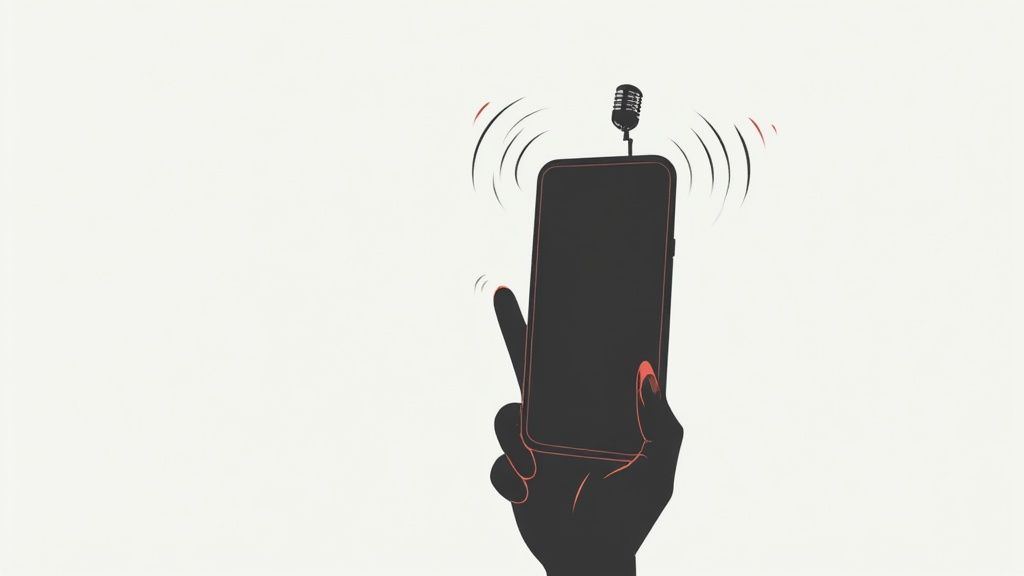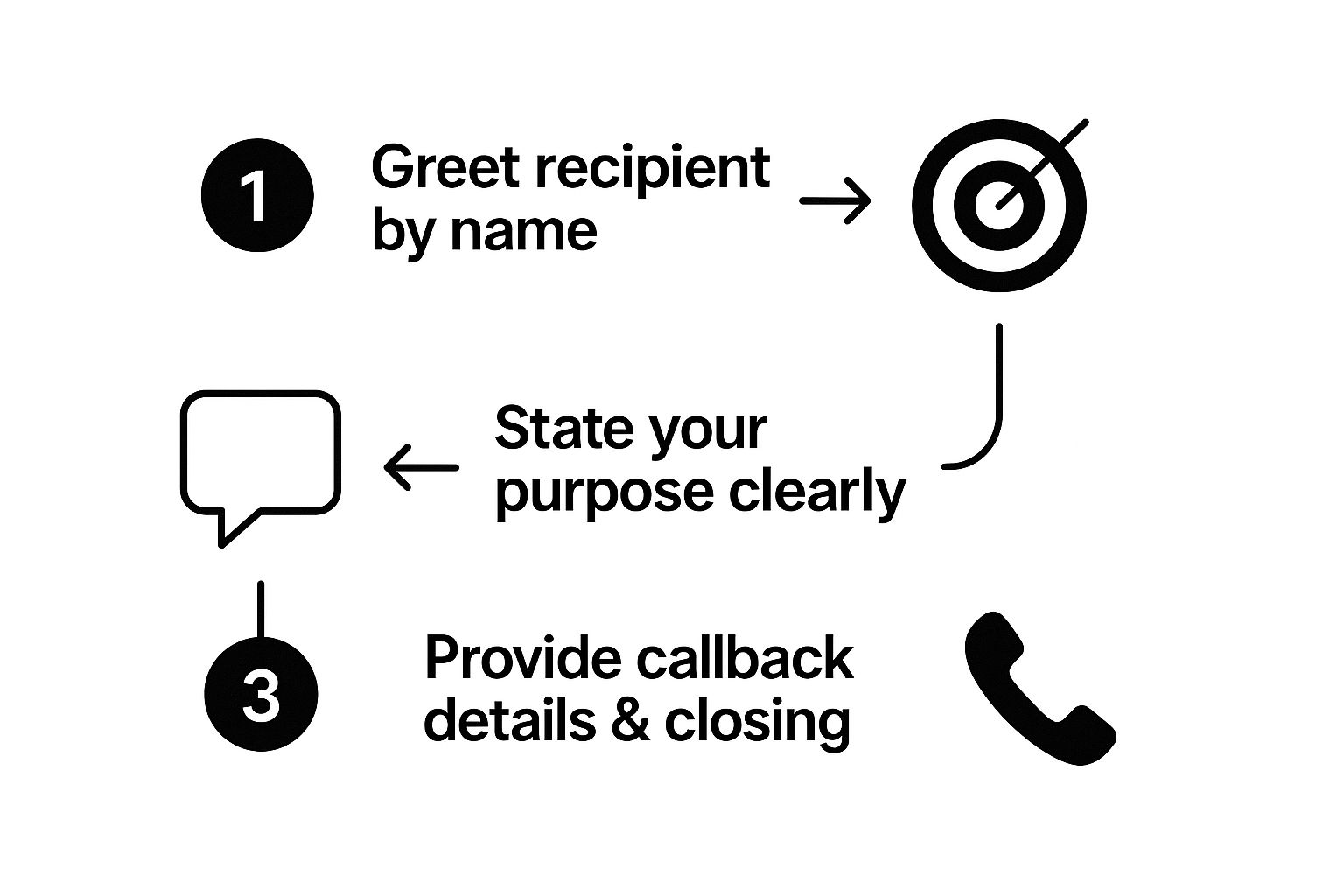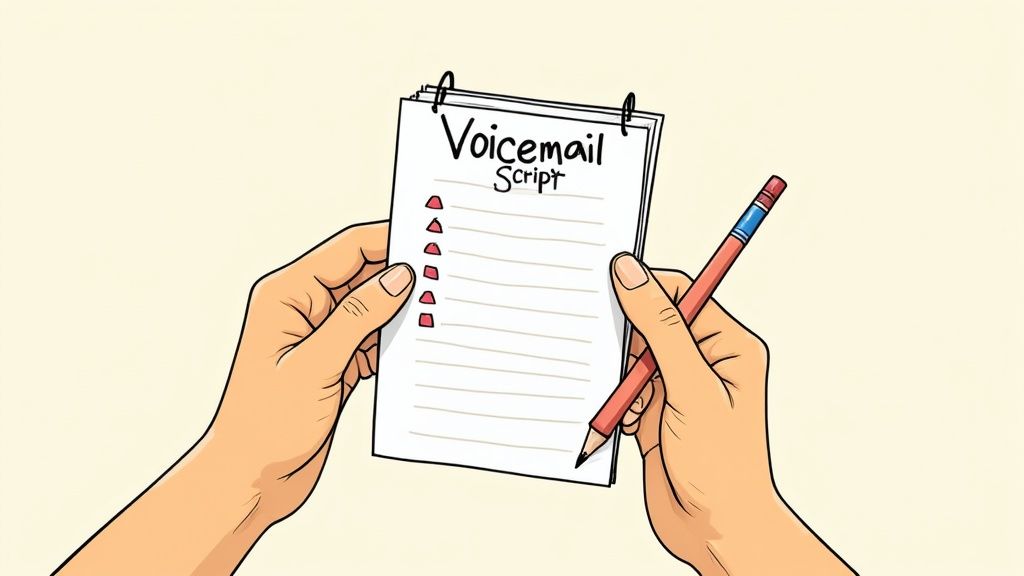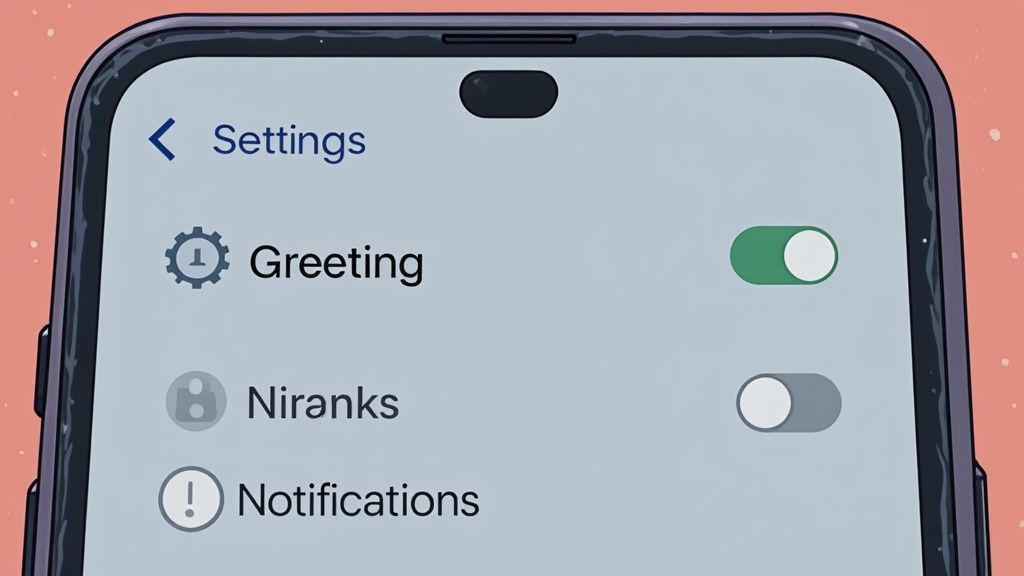Leaving a good voicemail is simple. Just state your name, your company, and why you’re calling right at the top. Before you hang up, slowly and clearly give your contact info and a specific next step. The whole thing should be under 30 seconds. It’s a direct, respectful approach that seriously boosts your chances of getting a call back.
Why Your Voicemail Still Matters in a Digital World

In a world drowning in emails, texts, and social media DMs, it’s easy to think of voicemail as a relic. Some people will even tell you not to bother leaving one at all. But I’ve seen firsthand how a well-crafted voicemail can be a service business's secret weapon, cutting straight through all that digital chatter.
Let's be real—nothing replaces the human voice. Unlike a text, your voice carries tone, sincerity, and a sense of professionalism that words on a screen just can't match. That personal touch can be the single thing that makes a potential customer choose you over the competition.
Building Trust Through Tone
Put yourself in the customer's shoes for a second. They have a problem, they call you, and they get your voicemail. Hearing a calm, confident, and friendly voice on the other end immediately starts building trust.
It tells them a real, competent human is ready to help solve their problem. This is absolutely critical for emergency services like a plumber dealing with a burst pipe or a tow truck driver responding to an accident.
This personal connection isn't just a "nice-to-have"; it’s a strategic edge. It turns a missed call from a frustrating dead end into a warm, promising lead. For any business that can't afford to let opportunities slip by, figuring out what an answering service is and how it can capture these crucial moments is a game-changer for growth.
A Proven Communication Channel
Voicemail is far from dead in professional circles. In fact, its value shines in structured environments where clear communication is non-negotiable.
For instance, data from one educational program showed that between 2010 and 2015, students required to leave voicemails for faculty did so with a compliance rate between 95.65% and 100%.
The takeaway is simple: When communication really counts, people fall back on proven, direct methods. Your voice message is a powerful signal to a potential client that their urgent need was heard by a professional, not just lost in a crowded inbox.
Ever feel like your voicemails just vanish into a black hole? You’re not alone. The difference between a message that gets deleted and one that gets a callback often comes down to having a clear, repeatable game plan.
Most people just wing it. That's a mistake. A truly effective voicemail isn’t a rambling monologue; it’s a sharp, professional tool designed to respect the listener’s time while making it crystal clear why they should call you back. You want to ditch the forgettable messages and start leaving voicemails that actually drive business.
The whole point is to have a simple, logical flow that guides your potential customer from "Who is this?" to "I need to call them back" without wasting a single second. It all boils down to starting strong, stating your purpose, and making it ridiculously easy for them to respond.
This flow chart gives you a bird's-eye view of what that looks like.

As you can see, it’s a direct path. No detours, no fluff—just the critical points delivered efficiently.
Start with Confidence and Clarity
Those first five seconds are everything. You have to nail the opening. Lead with your name and your company's name right away. A confident tone sets the stage and tells them you're a professional who values their time.
- Cut the weak intros. Ditch phrases like "Um, I was just calling to…" They immediately make you sound hesitant and unprepared.
- Be direct and clear. "Hi Sarah, this is Mike from Precision Plumbing." Simple. Powerful.
This straightforward approach signals that your call has a real purpose. It immediately frames the conversation in a professional light and makes them want to keep listening.
A warm, authentic, and succinct voicemail is your best shot at making a real connection. Your voice conveys sincerity and gratitude in a way text or email simply cannot match. It’s a personal touch in an impersonal world.
The Value Prop and The Ask
Once you've introduced yourself, get straight to the point. Why are you calling? Whether you’re following up on a quote or responding to a form they filled out on your website, state the reason clearly. This is your chance to connect your call directly to a need they have.
For instance, instead of a generic, "I'm calling about your project," get specific. Try something like, "I'm calling about the emergency repair request you submitted on our website for your property on Elm Street." See the difference?
Finally, you need a strong, simple call to action. Don't be vague. The most critical part is to end your message by slowly stating your name and phone number twice. I can't stress "slowly" enough. People are often scrambling for a pen and paper. A clear, repeated number is the single most important detail to get right if you actually want that return call.
To help you put it all together, here’s a simple table breaking down the essential parts of a high-impact voicemail.
Voicemail Structure for Maximum Impact
This table outlines the key components of an effective voicemail, explaining the goal of each part and providing simple phrasing you can adapt.
| Voicemail Component | Objective | Example Phrasing |
|---|---|---|
| The Opener | Immediately identify yourself and your company with confidence. | "Hi [Prospect Name], this is [Your Name] from [Your Company]." |
| The Context | Quickly connect the call to a prior interaction or known need. | "I'm calling in response to the inquiry you submitted on our website…" |
| The Value | Briefly state the benefit or solution you're offering. | "…about getting a free estimate for your kitchen remodel." |
| The Call to Action | Tell them exactly what to do next. Be specific. | "You can reach me directly at [Phone Number] to schedule a quick 10-minute chat." |
| The Close | Repeat your name and number slowly and clearly. | "Again, this is [Your Name] at [Phone Number]. Thanks, and I look forward to connecting." |
By following this structure, you're not just leaving a message; you're creating a clear and compelling reason for them to engage with you. It’s a small change that can make a huge difference in your callback rate.
Field-Tested Voicemail Scripts for Any Business Scenario

It’s one thing to know the theory behind a good voicemail, but it's a completely different ballgame when you're on the spot and the pressure is on. I've found the real key is to have a few go-to scripts in your back pocket that you can pull out and tweak as needed. This simple prep work takes the anxiety out of the equation and helps you sound like a calm, collected pro every single time you leave a voicemail.
Think of these less as rigid templates and more as flexible starting points for the most common situations your service business will run into. Whether you're calling a hot new lead or just giving a gentle reminder about a quote, the objective is always the same: be clear, be quick, and give them a reason to call you back.
For a New Website Lead
When someone takes the time to fill out a form on your website, they've basically just raised their hand and asked for your help. Your voicemail needs to be fast, directly reference what they did, and tell them exactly what to do next.
Example Script:
“Hi Alex, this is Brian from Apex Garage Doors. I’m calling in response to the request you just submitted on our website about your broken garage spring. I have an opening this afternoon to stop by for a free inspection. You can reach me directly at 555-123-4567. Again, this is Brian at 555-123-4567. Thanks.”
This approach works because it’s lightning-fast, highly specific, and immediately offers a solution. Mentioning the exact issue ("broken garage spring") instantly shows you're paying attention and you're already prepared to solve their problem.
Following Up on a Pending Proposal
We've all been there—clients get swamped, and that proposal you sent can easily sink to the bottom of a crowded inbox. A soft, helpful nudge can bring your estimate back to the top of their mind without making you sound desperate or pushy.
Example Script:
“Hi Jordan, it’s Maria with ClearView Window Cleaning. I’m just following up on the estimate I sent over last Tuesday for your storefront. I wanted to see if you had any questions about the service packages. You can call me back at 555-987-6543 when you have a moment. That’s Maria at 555-987-6543. Hope to hear from you.”
The tone here is everything. Your voice needs to communicate helpfulness, not impatience. You're framing the call as a service—calling to clarify things for them—which adds value and reinforces that you're a true professional.
To Re-Engage a Cold Lead
Every so often, a lead that seemed like a sure thing just goes dark. A well-timed voicemail can be just the thing to spark that conversation again. The trick is to reference your last chat and bring something new and valuable to the table.
Example Script:
“Hi Sam, this is David from D-Tech HVAC. We spoke a few weeks back about upgrading your air conditioning system before summer. I'm calling because we just started a spring promotion that could save you 15% on the unit we discussed. If you're still interested, feel free to call me back at 555-246-8109. Again, that’s David at 555-246-8109. Thank you.”
What makes this script so effective? It jogs their memory about a past conversation and immediately gives them a new, time-sensitive reason to care. That incentive creates a legitimate purpose for your follow-up and a compelling reason for them to pick up the phone and call you back now.
Common Voicemail Mistakes That Sabotage Your Callbacks
Even with a killer script, a few simple mistakes can get your message deleted instantly. When you leave a voicemail, you’re walking a fine line. Even tiny errors can undermine all your effort.
Figuring out these common traps is the first step toward fixing them—and getting more callbacks.
Forgetting Key Information
Let’s start with the most basic (and surprisingly common) mistake: forgetting crucial details. It’s painfully easy to hang up and realize you never even said your company’s name or why you were calling.
A simple pre-call checklist is the best fix. Before you dial, just make sure you have these four things ready to go:
- The client's name
- Your name and company
- The one-sentence reason for your call
- Your callback number (and be prepared to say it twice!)
Rambling or Rushing
Another major callback killer is rambling. When you don’t have a clear point, you just end up wasting their time and sounding unprepared. The fix? Before dialing, jot down the one key reason for your call. This simple habit forces you to be concise.
Speaking too quickly is just as bad, especially when you’re leaving your contact details. It’s incredibly frustrating for the listener, and most people won’t bother replaying the message to figure out what you said.
A great tip is to record yourself leaving a practice message on your own phone. When you play it back, you'll immediately hear if you're rushing or mumbling. It feels a bit strange at first, but it’s the fastest way to correct your pacing.
Sounding Robotic or Generic
Finally, sounding like a generic sales robot is a surefire way to get your message ignored. Your tone of voice is a powerful tool for making a real human connection. If your message comes across as stiff and scripted, it loses all its personal impact.
Here's a trick that works: try smiling while you're talking. It might sound silly, but it genuinely changes the tone of your voice, making you sound warmer and more approachable.
Remember, you’re a professional offering a valuable service, not just reading from a script. For more guidance on creating a positive caller experience, check out our in-depth article on call handling best practices.
Fixing these common errors will completely refine your technique. It’s what turns your voicemail from a forgettable message into a powerful tool that actually drives business.
Use Modern Tech to Supercharge Your Voicemail Strategy

Manually dialing number after number and leaving the same basic message is a huge time-sink. It’s a grind. But technology isn't here to replace the voicemail itself; it’s here to make the whole process a lot smarter and way more efficient.
Modern tools, like cloud-based phone systems and specialized outreach software, can automate the tedious parts of your process without stripping away that crucial personal feel. This tech gives your team back their time, so they can focus on actually serving customers instead of just trying to get them on the phone.
Gain Serious Efficiency with Voicemail Drops
One of the most powerful tools I’ve seen emerge is voicemail drop software. It’s pretty slick. You pre-record a perfect, studio-quality voicemail message and then "drop" it directly into a prospect's inbox right after the beep—your phone never even rings on their end.
Think about it. You have a list of 50 leads to follow up with. Instead of dialing, waiting for the beep, and repeating yourself 50 times, you can deliver a flawless, high-energy message to every single one in just a few minutes. It's a massive productivity jump for any service business doing outreach.
Voicemail drops aren’t about being impersonal or robotic. They're about ensuring every single message you leave is your absolute A-game. It guarantees your branding and core message are consistent, every single time.
Turn Your Voicemails into Actionable Data
Another game-changer is voicemail transcription. These services take your audio messages and automatically convert them into text that you can search, organize, analyze, and even sync directly with your Customer Relationship Management (CRM) system.
Suddenly, a simple voice message transforms into a valuable piece of data. This isn't just a niche tool anymore; the demand is exploding. The voicemail transcription market is on track to grow by about 11% every year, with businesses driving that demand, making up nearly 70% of the market. You can dig into the specifics in data analysis reports on this trend.
When you combine these technologies with an AI assistant, you can build an incredibly efficient system. An AI can handle the initial call intake, and then you can use voicemail drops for all your follow-ups, creating a smooth and professional customer experience from start to finish. Taking a look at virtual receptionist pricing can show you just how affordable and effective this kind of modern setup really is.
Got Questions About Voicemails? We've Got Answers.
Even when you've got the best scripts down, you’ll run into situations that make you pause and wonder, "What's the right move here?" It happens. Getting clear, quick answers to these common sticking points means you can leave every single message with confidence.
Let's dive into the questions I hear most often from other service pros.
What’s the Ideal Length for a Business Voicemail?
You're aiming for the sweet spot: between 20 and 30 seconds. This is just enough time to hit all the key points—your name, company, why you're calling, and your number—without making the other person feel like they're listening to an epic novel.
Go much longer, and you risk them tuning out completely. A message that's too short can come across as rushed or incomplete, but one that rambles on just shows you don't respect their time. Practice timing yourself a few times; you'll get a feel for that quick, concise format pretty fast.
How Many Times Should I Actually Call and Leave a Message?
My rule of thumb is to cap it at two or three voicemails over a couple of weeks. There's a fine line between being persistent and becoming a pest, and you want to stay firmly on the professional side of that line.
- Call #1: Your first message. Keep it clear, friendly, and informative.
- Call #2: Wait about 3-5 business days. You can try a slightly different angle, maybe mentioning a new piece of information or benefit.
- Call #3: Give it another week. This is your final, polite "last try" call before you decide to switch tactics.
If you’ve left three thoughtful messages and still hear crickets, it’s time to move on to email. Pushing further with calls will only hurt your chances.
What if I Still Don't Get a Callback?
When your calls just aren't landing, don't take it personally—just change your strategy. After that final voicemail attempt, it's time to pivot to email.
Send a brief, polite email that references your previous calls. Restate why you reached out and the value you can provide, but keep it incredibly short and to the point.
In high-stakes situations, voicemail serves as a critical interface for direct, sensitive communication when other channels are too impersonal. It reinforces that a real person is attempting to connect on an important matter. You can explore more about this dynamic in commentary on communication strategies.
If you still get no reply, you can even try a "breakup" email. Something simple like, "It seems like now isn't the right time, so I'll go ahead and close out your inquiry for now" can often trigger a response because it creates a sense of friendly finality.
Never miss another opportunity because you couldn't get to the phone. With Marlie Ai, every call is answered 24/7 by a professional AI assistant that books jobs, captures lead details, and ensures your customers feel heard. Discover how Marlie Ai can help you book 60% more work.

